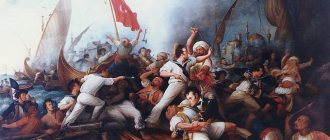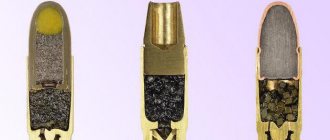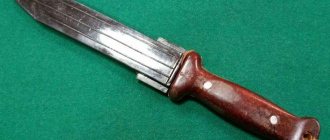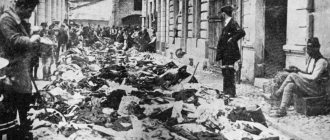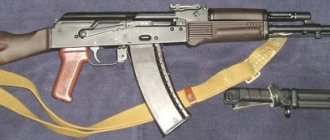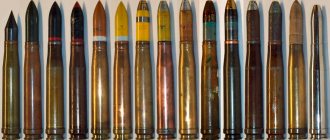The history of the appearance of the whip
It is difficult to trace the exact time of the appearance of the first lashes. Initially, the whip was common among the peoples of Asia, and then spread throughout Europe and even to America (cowboys).
It is known that ancient peoples used flagellation to enhance fertility; this is how they cast a spell on the harvest. Among some peoples, it was customary to whip sculptures and images of gods in order to receive their help. It was also believed that blows from whips stimulated fertility in both men and women.
Warlash
Use of whips among nomadic peoples
To understand what a whip is for nomadic peoples, you need to take a short excursion into history. Since time immemorial, nomads have used whips, whips, whips and whips for three main functions:
- shepherd's scourge in cattle breeding;
- military weapons;
- hunting tool.
In the XI-VIII centuries. BC. The Assyrians use the whip for more accurate shooting of horse archers. Until the Middle Ages, the whip was one of the most important attributes of the uniform of an equestrian warrior. Moreover, the whip as an original weapon is preserved among some peoples (Kalmyks, Kazakhs, Tuvans, Kyrgyz) to the present day.
See also the article Professional combat archery
In addition, nomadic peoples (especially the Kyrgyz) often used whips for horse fights: the goal of the opponents was to knock each other out of the saddle with a blow of a whip (“naked fighting”). This type of competition was preserved among the Kirghiz until the twentieth century.
The purpose of these fights was to teach how to fight not only with the help of the main weapon, but also using an improvised weapon.
A whole system of strikes was developed for the fight.
In the hands of experienced owners, the whip turned into a powerful weapon: a precise blow from the whip could break the wolf’s back. In battle, when struck, the whip could knock out an eye, tear clothes, affect a horse, and in addition, it could not be protected from it with a shield.
The whip, as a rule, was attached to the wrist, while allowing free use of the hand.
Whip in antiquity
In antiquity, lashing was a special punishment for slaves. The whips were stuffed with special devices for more effective and painful blows: lead balls, sharp lamb bones, ox sinews.
Scourges were an attribute of some gods in Ancient Rome (Apollo, Dionysus, Bellona, etc.). In addition, the practice of whipping women was often used to increase their fertility. Also, victorious commanders decorated their chariots with whips.
Whips, arapniks and whips in Russia
In Russian military practice, arapniks and whips, as a rule, had the following form: a short wooden handle, as thick as a finger, a braided base made of leather straps, and two (and after 1839) tails.
In the 17th century, whips were used as punishment by ecclesiastical courts for both clergy and secular persons subject to the jurisdiction of the church court.
Photo of the whip
In Domostroi, the whip was indicated as an instrument of domestic punishment. In addition, on the wedding day, the groom had to put a whip in his boot, so that marital power in the house belonged to him.
Whips were used as punishment for serfs and for students in educational institutions.
The police used whips to punish them.
In secular courts, the whip has been used as a punishment since the 18th century, and later became the most severe punishment. Flogging took place publicly and was carried out by the executioner; it was prescribed both as an independent punishment and in combination with other types of punishment. After a public fight, a person could not be given up for military service.
The grounds for imposing this type of punishment were the following: crime against the state, participation in a riot, murder. Soon lashes are increasingly introduced into practice, instead of the more severe punishment of the whip.
In the second half of the 19th century, lashes were excluded from the ladder of punishment and were retained in small quantities for men in exile.
LiveInternetLiveInternet
The Scourge begins its history several thousand years ago. During this time, it underwent many changes, changing its purpose, appearance, material and names. As a shepherd's whip, she helped the peaceful shepherd manage his flock. During traditional Russian hound hunting, nobles and commoners used a hunting whip to finish off wounded game. It was driven by dogs and horses. The whip and rods were widely used for punishment, both in the army or prison, and on noble estates. The whip was also widely used for military purposes. A heavy single-tailed whip with an oval or pear-shaped metal weight, called a flail or a Roman whip, was in service with the Mongol horde, Russian squads and Roman legionnaires. Sjambok - a South African hunting whip was used as a weapon of self-defense and in non-lethal fights. The Cossack whip was not only an integral attribute of the Russian Cossacks, but also its symbol. However, most of all, the whip and whip turned out to be in demand for torture and punishment. In ancient Judea, lawbreakers were punished with the whip. Slaves in South America were brutally whipped with a Jamaican whip. The Holy Inquisition beat out confessions and repentance from sinners with a whip. The Russian anti-hero Malyuta Skuratov dealt with his enemies with a whip and rods in his “torture chambers”. In the Russian Empire, for a long time, the main instrument of corporal punishment was the whip, which the country adopted from the Tatars. Whips and whips were also widely used as instruments of torture during interrogations. To make torture more severe, the design of the whip was repeatedly improved, and the technique of use became more complicated. In Muslim Egypt, whips were made from two leather strips, into one of which small nails were driven before stitching and then the caps were covered with a second strip. When struck, such a whip was wrapped around the body of a standing victim, then, when it was jerked back, the embedded nails tore the interrogated body to shreds. The scourging procedure was carried out in different ways. The victim was laid on a wooden bench with his stomach down, his arms and legs extended along the bench were fixed to rings nailed into the legs of the bench. The head was pressed so tightly against the tree that the victim had no opportunity to scream, and this greatly increased the pain. Sometimes the victim was hung by his legs spread wide apart, head down, in order to strike the genitals. This was done especially often with women. If they did not confess from the first blows, the torture was intensified, beating the unfortunates on the breasts, trying to hit the nipples more often, which gave the torture a pronounced sexual connotation. In Russia, the hunter's and military's whip appeared in the 12th century after the invasion of Genghis Khan. The rawhide whip was used in battle, hunting, punishment and even execution. The art of mastering combat techniques was studied along with other types of weapons. To this day, the rawhide whip is part of the arsenal of the Russian Cossack, who must undergo a special training course in combat techniques. The correct and skillful use of the whip required extensive study, as well as strong nerves and muscles. Executioners and torturers underwent many years of training. A good specialist, using various technologies, could radically change the entire format of torture. He could kill the victim with one blow, or he could turn the execution into a harmless show. The executioner's skill made it possible, by varying the technique of blows with the help of broaches, to leave the punished person's back without skin without damaging internal organs, or to make him disabled for life, causing serious damage to the chest or the most important organs located in the abdomen. Skilled craftsmen could use a whip, like an extension of their hand, to hit or grab the smallest objects without touching nearby ones, or with one blow they could literally smash a solid brick into dust. The art of weaving rawhide lashes and whips has a history of more than 1000 years. The secrets of weaving have been passed down from generation to generation for many centuries.
Snake is a version of the whip, generally without a rigid handle.
Single-tailed universal whip (Dog).
Single-tailed long whip.
“Evil Snake” The whip is flexible, without a handle, round braided, with two braided tails.
Single-tailed short braided whip
Whip "Shustrik".
Don whip. The length of the whip handle is 300–400mm. The length of the flexible part is 450–550mm. Natural leather. Natural wood.
Single-tailed black whip with rhinestones. Whip weaving. Length: 1100–1200 mm.
The whip is light. Length 1450 mm. A long flexible handle that turns into a thin braided cord with a tassel at the end.
Braided leather whip. Length 1350–1500 mm.
Beach "Soaring eagle with snake".
1.
Small and large bull whip.
2.
Series of messages “All sorts of things”:
Part 1 - It's a man's world Part 2 - A dream ... Part 12 - Without a title Part 13 - Gifs Part 14 - The history of lashes, knouts, rods Part 15 - Design from water pipes Part 16 - Sufi hoods ... Part 18 — Labyrinth Part 19 — Video Editor Part 20 — Friends and Readers
The whip and its uses
The whip has the following form: a long braided leather belt, thinned at the end, to which is attached a narrow belt (foul), also thinning towards the end so that its very edge reaches the width of a horsehair (cracker).
When struck, the foul develops supersonic speed and the cracker produces a characteristic sound similar to a click. Whips are often woven from other materials (synthetic ropes).
The whip is used to solve three problems:
- Prodding animals. The cattle are frightened by the crack the whip makes and listen to the shepherd's instructions.
- Punishing people. The right blow of the whip cut the skin and nearby tissues to the bone. After every 10-15 blows, the whip became damp with blood, so it had to be changed. One of the most severe and cruel types of punishment.
- Flexible impact weapon.
See also the article Slingshot as a weapon and its types
Combat Whip
Gingerbread cookies with a whip in perspective (2 photos)
Frankly speaking, there is something to be surprised about. On the one hand, there is the strange stubbornness of the people of Russia, who see in the vaccine something even more terrible than the Christians of the Roman Empire saw in the seal of the Antichrist.
And on the other hand, such tender care for this stubborn people.
It would seem that give people the freedom to choose to live or die. The treatment of patients and the costs of opening new Covid centers are not as frighteningly high as the state of mind and psyche of its own population.
Another thing is surprising. Why are the authorities so keen to achieve this very vaccination by any means, sparing no money and other benefits, if only the percentage of vaccinated people reaches the European level.
The authorities are not afraid of the front, they are not afraid of the fact that budget costs for the same healthcare are much less than for vaccination, that the people are collecting petitions and appealing to the Duma with protests.
However, the authorities are not backing down. Carrot and stick measures, coercion and persuasion measures are always better than repressive ones. And it is precisely this kind of policy that suggests that the authorities will not retreat. No matter how strange it may be, they need a percentage at all costs.
Percentage and only percentage. For what? To show itself as a cultural country, following the path of necessity like the rest of the West?
After all, we decided, given the availability of gas and oil, nuclear and hydroelectric power plants, to switch to alternative energy, which is, in principle, unnecessary and expensive for us. With a dead industry, we nevertheless sign agreements on emissions quotas.
With a meager meat and dairy industry, we are introducing new rules for farmers that will force them to reduce the number of cattle.
We want to plow the fields and return to crop rotation the farmland lost over thirty years of restructuring, and at the same time we sign demands one after another to reduce emissions of methane, carbon dioxide and other gases that no longer come from industrial production, but from agriculture. And at the same time, we understand that without increasing these emissions we will not be able to achieve import substitution, and without this substitution the entire country and its people will not survive. We are doing what the West dictates, but at the same time we are quietly trying to break out of the loop.
Isn’t this the same reason why we are fighting so hard for the vaccine percentage? The authorities are still the authorities, not the average person. She sees many things further and higher, with a perspective that the average person lacks. The authorities know a lot, but they are tied to capitalism in its most terrible guise: genocide. This means that she will never admit the reasons for her actions and will not tell the people directly and honestly what the matter is.
In this situation, we will only have to guess: the percentage of vaccinated people is a condition for loyalty to Russia on the part of the West. It won’t exist, and at any moment Western capitalism, driven into a corner, can declare Russia a threat to humanity. The sick infected population must be isolated from the world or destroyed.
How do you like this prospect? While refugees are crowding on the Polish-Belarusian border, we can continue to fight for the percentage of vaccinated people without damaging our own image. So what is next? What else will the West invent to fulfill its goal: Carthage must be destroyed?
Oh, we don’t want our government and its elite to be among the outcasts. They know what they will lose.
